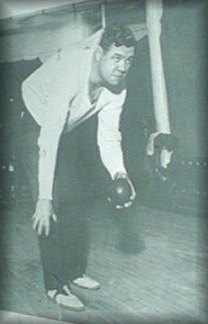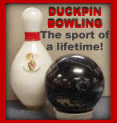  THE HISTORY OF DUCKPIN BOWLING THE HISTORY OF DUCKPIN BOWLING
Duckpin bowling
was born in Baltimore, Maryland, has been around since 1900. It was one of Babe Ruth's favorite games, besides baseball, of course! Ten-pin bowling used to be strictly a winter sport. Most alleys closed
down for the summer, but a few of them remained open so that bowlers could practice with small balls, about 6 inches in diameter.
They usually played odd games called "back five," using just the 5, 7, 8, 9, and 10 pins, and "cocked hat,"
which used only the 1, 7, and 10. In 1900, summer bowlers at the Diamond Alleys in Baltimore suggested it might be interesting
to trim down the standard pins to match the size of the ball. Manager John Van Sant liked the idea. He had a wood turner do
the job and many of his customers enjoyed the new bowling game. At first, the rules of ten-pin bowling were used. But, because
it's much harder to get strikes and spares, one small rule change was made: A bowler is allowed to use three bowls on
each turn. If all ten pins are knocked down with three balls, it simply counts a score of ten. Van Sant demonstrated
the new sport to the owners of the alley, John McGraw and Wilbert Robinson. Though they're much better known as baseball
managers, McGraw and Robinson were also avid duck hunters. When they saw the way the small pins flew wildly around the alley,
one of them remarked that it looked liked a "flock of flying ducks." That was the beginning of duckpin bowling.
Originally a summer sport, it became so popular in the area that winter leagues were organized in Baltimore in 1903 and in
Washington, D. C., in 1904. During the 1920s, duckpin bowling spread along the east coast, from New England to Georgia. While
the rules were basically the same everywhere, balls, pins, and lane sizes weren't standardized. The National Duckpin
Bowling Congress (NDBC), founded in the fall of 1927, worked with member organizations and manufacturers to bring about standardization.
The NDBC held its first national tournament, patterned after the American Bowling Congress's ten-pin tournament, in the
spring of 1928. There were 126 five-person teams, 162 doubles teams, and 201 singles entries. Duckpin bowling grew rapidly
during the 1930s. By 1938, an estimated 200,000 bowlers were participating in sanctioned league play. Growth continued
more slowly after World War II, reaching a peak of 300,000 sanctioned bowlers in 1967. The sport's popularity has declined
greatly since then, but it's still strong in a narrow geographical region from Washington and Baltimore to Connecticut
and Rhode Island. A variation, rubberband duckpin bowling, developed during the late 1930s. The pins are circled with
bands of hard rubber that increase pin action and scores. In 1946, the NDBC created an affiliate, the American Rubberband
Duckpin Bowling Congress, to sanction leagues and conduct a national tournament. The rubberband version of the sport never
spread very far beyond the Baltimore-Washington area. Bowling History courtesy of: Hickock's Sports History
 HOW TO PLAY THE GAME HOW TO PLAY THE GAME
The rules of duckpin bowling are easy to learn, and once you become acquainted with
the basic rules of play, you will be ready to roll in no time at all.
 A regulation game consists of 10 frames, or boxes. A bowler is allowed up to three balls per frame to knock down as many pins
as possible A regulation game consists of 10 frames, or boxes. A bowler is allowed up to three balls per frame to knock down as many pins
as possible
If all ten pins are knocked down by the first ball in any frame, it is called a 'Strike'
and is usually symbolised on the score sheet with an X.
A Strike counts as 10 plus the total
of the pins knocked down with the next two balls that are rolled.

| Strike Symbol
(counts 10 + next two balls) |
If all ten
pins are knocked down with the first two balls in any frame, it is called a 'Spare', and is usually symbolised
with a diagonal line on the score sheet. A spare counts as 10 plus the total of the pins knocked down on the next
ball rolled.

| Spare Symbol
(counts 10 + next ball) |
 If the bowler fails to get a strike or a spare, he/she rolls the third ball to get the remaining pins and the total
pins knocked down on three balls becomes the score for that frame. If the bowler fails to get a strike or a spare, he/she rolls the third ball to get the remaining pins and the total
pins knocked down on three balls becomes the score for that frame.
Score is kept in an accumulated
manner, left to right, through the 10 frames, with a perfect game being 300. Information is from the brochure of
the Duckpin Bowling Proprietors of America.
A PERFECT GAME OF 300 HAS NEVER BEEN BOWLED. THE HIGHEST SCORE EVER THROWN WAS 279.
DUCKPIN WORLD RECORDS
|
Current Thru March 2006
|
| Men's |
| 03/05/1992 |
Single Game |
Pete Signore Jr. |
T-Bowl Lanes, Newington, CT |
279 |
| 04/24/1978 |
Three Game Set |
Jeff Pyles |
Glenmont Bowl, Wheaton, MD |
655 |
| 08/15/1994 |
Four Game Set |
Nappy Ranazzo |
Fair Lanes, Westview, Baltimore, MD |
758 |
| 05/20/1988 |
Five Game Set |
William Schwartz |
Greenway Bowl East, Baltimore, MD |
988 |
| 11/17/1984 |
Six Game Set |
James E. Deviers |
Luray Lanes, Luray, VA |
1116 |
| 04/27/1985 |
Seven Game Set |
Jeff Pyles |
Greenway Bowl East, Baltimore, MD |
1329 |
| 08/05/1995 |
Eight Game Set |
Jeff Pyles |
Long Meadow Bowl, Hagerstown, MD |
1412 |
| 01/14/1989 |
Nine Game Set |
Steve Iavarone |
Town Hall Lanes, Johnston, RI |
1535 |
| 04/05/1980 |
Ten Game Set |
Jeffrey Ferrand |
Holiday Lanes, Manchester, CT |
1760 |
| 02/27/1993 |
Twelve Game Set |
Scott Wolgamuth |
Lucky Strike Lanes, Mansfield, CT |
2066 |
| 06/09/1979 |
Fifteen Game Set |
Charles "Buddy" Creamer |
Fair Lanes P.G., Hyattsville, MD |
2482 |
| 08/13/1996 |
Twenty Game Set |
Jeff Pyles |
GWDA 30 Game Classic - Var Lanes |
3170 |
| 08/15/1996 |
Twenty-Five Game Set |
Jeff Pyles |
GWDA 30 Game Classic - Var Lanes |
4028 |
| 08/17/1996 |
Thirty Game Set |
Jeff Pyles |
GWDA 30 Game Classic - Var Lanes |
4835 |
| 1982/1983 |
Season Average |
Jeff Pyles |
Wheaton Triangle, Wheaton, MD |
164.47 |
| Women's |
| 05/06/1973 |
Single Game |
Carole Gittings |
Fair Lanes Timonium, Timonium, MD |
265 |
| 06/16/1988 |
Three Game Set |
Diane Jasper |
Suitland Bowl, Suitland, MD |
586 |
| 11/28/2005 |
Four Game Set |
Amy Bisson |
T-Bowl Lanes, Newington, CT |
741 |
| 03/20/2005 |
Five Game Set |
Amy Bisson |
Rivieria Lanes, Pasadena, MD |
877 |
| 11/27/2004 |
Six Game Set |
Amy Bisson |
Perillo's Bowladrome, Waterbury, CT |
1006 |
| 03/20/2004 |
Seven Game Set |
Amy Bisson |
Riviera lanes, Pasadena, MD |
1173 |
| 10/16/2005 |
Eight Game Set |
Amy Bisson |
AMF Eastpoint, Baltimore, MD |
1360 |
| 05/20/1989 |
Nine Game Set |
Pat Malthan |
Fair Lanes Southwest, Linthicum, MD |
1421 |
| 02/10/1979 |
Ten Game Set |
Kathy Spindler-Lischio |
Collinwood Lanes, Portsmouth, VA |
1508 |
| 05/14/1983 |
Twelve Game Set |
Veronica Schwarzkopf |
Fair Lanes Westview, Baltimore, MD |
1806 |
| 06/09/1979 |
Fifteen Game Set |
Patricia Rinaldi |
Fair Lanes P.G., Hyattsville, MD |
2310 |
| 08/12/1997 |
Twenty Game Set |
Theresa Vermillion |
GWDA 30 Game Classic - Var Lanes |
2860 |
| 08/14/1997 |
Twenty-Five Game Set |
Theresa Vermillion |
GWDA 30 Game Classic - Var Lanes |
3537 |
| 08/16/1997 |
Thirty Game Set |
Theresa Vermillion |
GWDA 30 Game Classic - Var Lanes |
4204 |
| 2005/2006 |
Season Average |
Amy Bisson |
Highland Bowl, Cheshire, CT |
155.08 |
|

